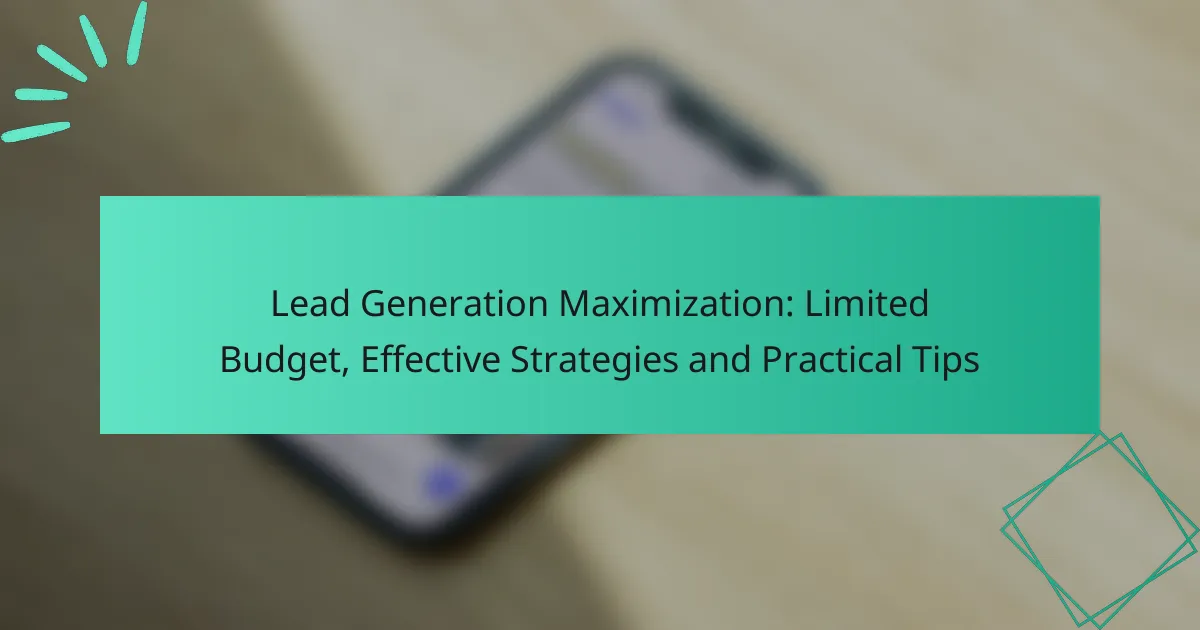Maximizing lead generation on a limited budget is achievable through strategic use of cost-effective marketing channels and engagement techniques. By leveraging digital platforms and community resources, businesses can attract potential customers without incurring significant expenses. Prioritizing target audiences and setting clear goals further enhances the effectiveness of these efforts, ensuring that limited resources yield maximum returns.

How can lead generation be maximized on a limited budget?
Maximizing lead generation on a limited budget requires strategic use of low-cost marketing channels and effective engagement techniques. Focus on leveraging digital platforms and community resources to attract potential customers without significant financial investment.
Utilizing social media platforms
Social media platforms are powerful tools for lead generation, allowing businesses to connect with their audience at little to no cost. Create engaging content tailored to your target demographic, and use features like polls, stories, and live videos to foster interaction.
Consider platforms like Facebook, Instagram, and LinkedIn, which offer targeted advertising options that can fit various budgets. Regularly analyze engagement metrics to refine your strategy and focus on the platforms that yield the best results.
Implementing email marketing campaigns
Email marketing remains one of the most cost-effective ways to generate leads. Build a subscriber list through your website or social media, and send out regular newsletters with valuable content, promotions, or updates to keep your audience engaged.
Utilize free or low-cost email marketing tools to automate campaigns and segment your audience for personalized messaging. Aim for a consistent schedule, but avoid overwhelming your subscribers with too many emails.
Leveraging content marketing strategies
Content marketing can drive organic traffic and generate leads without a hefty budget. Create high-quality blog posts, infographics, or videos that address your audience’s pain points and interests, establishing your brand as a trusted resource.
Optimize your content for search engines to increase visibility, and share it across social media platforms. Consider guest posting on relevant blogs to expand your reach and attract new leads.
Engaging in community networking
Community networking can be an effective way to generate leads locally. Attend local events, join business associations, or participate in community service to connect with potential customers and other businesses.
Building relationships within your community can lead to referrals and partnerships. Be genuine in your interactions, and always have business cards or promotional materials on hand to share with interested parties.
Optimizing website for SEO
Search engine optimization (SEO) is crucial for attracting organic traffic to your website. Focus on optimizing on-page elements like titles, meta descriptions, and headers with relevant keywords to improve your search rankings.
Regularly update your website with fresh content and ensure it is mobile-friendly. Utilize tools like Google Analytics to track performance and identify areas for improvement, helping you attract more leads without additional costs.

What are effective low-cost lead generation strategies in Canada?
Effective low-cost lead generation strategies in Canada focus on maximizing outreach while minimizing expenses. By leveraging digital tools and local engagement, businesses can attract potential customers without significant financial investment.
Creating targeted landing pages
Targeted landing pages are essential for converting visitors into leads. These pages should be tailored to specific audiences, highlighting relevant offers or services that resonate with their needs. Use clear calls-to-action (CTAs) and ensure the design is user-friendly.
To create effective landing pages, consider A/B testing different headlines, images, and CTAs to see which combinations yield the highest conversion rates. Aim for a load time under three seconds to prevent drop-offs.
Utilizing local SEO techniques
Local SEO techniques help businesses appear in search results relevant to their geographic area. This involves optimizing your website with local keywords, creating a Google My Business listing, and encouraging customer reviews.
In Canada, focus on incorporating city names and local terms in your content. Regularly update your listings and engage with customer feedback to enhance visibility and credibility in local searches.
Participating in local events
Engaging in local events is a powerful way to generate leads while building community relationships. Attend trade shows, fairs, or networking events to showcase your products or services and connect with potential customers face-to-face.
Consider sponsoring local events or hosting workshops to increase brand awareness. Collect contact information through sign-up sheets or digital forms to follow up with interested attendees after the event.
Building referral partnerships
Building referral partnerships with other local businesses can significantly enhance lead generation efforts. Collaborate with complementary businesses to exchange referrals, which can expand your reach without additional costs.
Establish clear terms for referrals, such as offering a commission or reciprocal referrals. Regularly communicate with partners to ensure mutual benefits and maintain strong relationships that can lead to increased business opportunities.

How can businesses prioritize lead generation efforts?
Businesses can prioritize lead generation efforts by focusing on their target audience, setting clear goals, and analyzing competitor strategies. These steps help allocate limited resources effectively while maximizing potential returns.
Identifying target audience segments
Identifying target audience segments is crucial for effective lead generation. Businesses should analyze demographics, interests, and behaviors to create detailed buyer personas. This allows for tailored marketing strategies that resonate with specific groups.
Consider using tools like surveys or social media analytics to gather insights about your audience. Segmenting your audience can lead to higher engagement rates and improved conversion metrics.
Setting measurable goals
Setting measurable goals helps businesses track their lead generation progress. Goals should be specific, achievable, and time-bound, such as generating a certain number of leads per month or increasing conversion rates by a specific percentage.
Utilize the SMART criteria (Specific, Measurable, Achievable, Relevant, Time-bound) to define your objectives. Regularly review these goals to adjust strategies as needed and ensure alignment with overall business objectives.
Analyzing competitor strategies
Analyzing competitor strategies provides valuable insights into effective lead generation techniques. By studying what works for competitors, businesses can identify gaps in their own strategies and adopt successful tactics.
Look at competitors’ online presence, content marketing efforts, and social media engagement. Tools like SEMrush or Ahrefs can help assess their SEO strategies and keywords. This analysis can inform your own approach to attract leads more effectively.

What tools can enhance lead generation on a budget?
Several cost-effective tools can significantly boost lead generation efforts without straining your budget. By leveraging platforms like HubSpot, Mailchimp, and Google Analytics, businesses can streamline their processes, improve outreach, and track performance effectively.
Using HubSpot for CRM
HubSpot offers a free CRM that helps manage customer relationships efficiently. It allows users to track interactions, manage contacts, and automate follow-ups, making it easier to nurture leads over time.
To maximize its potential, focus on setting up pipelines that reflect your sales process. Utilize the email tracking feature to see when leads engage with your communications, which can inform your follow-up strategy.
Be cautious of overcomplicating your setup; start with essential features and gradually incorporate advanced tools as your needs grow. Regularly review your CRM data to refine your lead generation tactics.
Employing Mailchimp for email marketing
Mailchimp is a popular email marketing platform that offers a free tier for small businesses. It enables users to create targeted email campaigns, automate responses, and analyze engagement metrics to optimize future outreach.
For effective lead generation, segment your audience based on their interests or behaviors. This targeted approach can enhance engagement rates and conversion potential. Consider using A/B testing to refine your email content and subject lines.
Avoid sending too many emails, as this can lead to unsubscribes. Instead, focus on providing valuable content that addresses your audience’s needs and interests.
Utilizing Google Analytics for tracking
Google Analytics is a powerful tool for tracking website performance and user behavior. It provides insights into how visitors interact with your site, which can inform your lead generation strategies.
Set up goals to measure conversions, such as form submissions or newsletter sign-ups. Use the data to identify which traffic sources are most effective and adjust your marketing efforts accordingly.
Be mindful of data privacy regulations, such as GDPR, when collecting user information. Ensure that your tracking practices comply with local laws to maintain trust and credibility with your audience.

What metrics should be tracked for lead generation success?
To measure lead generation success, focus on key metrics such as conversion rates and cost per lead. These metrics provide insights into the effectiveness of your strategies and help optimize your budget allocation.
Conversion rates
Conversion rates indicate the percentage of leads that take a desired action, such as making a purchase or signing up for a newsletter. Tracking this metric helps assess the effectiveness of your marketing efforts and identify areas for improvement.
To calculate conversion rates, divide the number of conversions by the total number of visitors or leads, then multiply by 100. For example, if 50 out of 1,000 visitors convert, your conversion rate is 5%. Aim for conversion rates in the range of 2-5% for most industries, but higher rates may be achievable with targeted strategies.
Cost per lead
Cost per lead (CPL) measures the total cost incurred to acquire a single lead. This metric is crucial for understanding the efficiency of your lead generation campaigns and managing your budget effectively.
To calculate CPL, divide the total marketing expenses by the number of leads generated. For instance, if you spend $1,000 on a campaign and generate 100 leads, your CPL is $10. Keeping your CPL low while maintaining quality leads is essential, with many businesses targeting a CPL of under $50.



